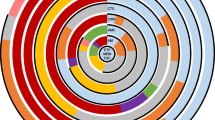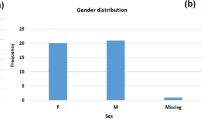Abstract
The aims of the present study were to characterize the mechanisms of resistance to fluoroquinolones, macrolides, and imipenem in Haemophilus influenzae, to assess the extent of the AcrAB-TolC-mediated resistance, and to define a core genome multilocus sequence typing (cgMLST) scheme for H. influenzae by using whole-genome sequencing. Four amino acid substitutions in GyrA (at Ser84 and Asp88), ParC (at Ser84), and ParE (at Asp420) were found to be closely associated to the MICs. We did not find any amino acid substitution surrounding the three highly conserved amino acid motifs in PBP3 related to imipenem resistance. All the isolates possessed the ermB gene. Carbonyl cyanide m-chlorophenylhydrazone (CCCP) decreased the MIC of imipenem by twofold for FQR-6 and fourfold for GE47 and GE88 strains. For erythromycin, the MICs were decreased by twofold. We found that the six FQR isolates were clustered in two groups. The number of different loci within FQR-1_FQR-3_FQR-5 cluster was 6, while FQR-2 and FQR-4 differed for 21 loci. FQR-1_FQR-3_FQR-5 and FQR-2_FQR-4 clusters were distant among each other and compared to 19 genomes downloaded from NCBI, to 8 strains heteroresistant to imipenem, and to 4 strains monoresistant to ciprofloxacin isolated in Denmark. We confirmed that specific amino acid substitutions in GyrA, ParC, and ParE are implicated in quinolone resistance. Additionally, the degree of resistance is related to the number of these amino acid substitutions. We provide robust evidence that drug efflux is one of the substantial mechanisms of imipenem and erythromycin resistance in H. influenzae.


Similar content being viewed by others
References
Rennie RP, Ibrahim KH (2005) Antimicrobial resistance in Haemophilus influenzae: how can we prevent the inevitable? Commentary on antimicrobial resistance in H. Influenzae based on data from the TARGETed surveillance program. Clin Infect Dis 41(Suppl 4):S234–S238
Agrawal A, Murphy TF (2011) Haemophilus influenzae infections in the H. Influenzae type b conjugate vaccine era. J Clin Microbiol 49(11):3728–3732
Erwin AL, Smith AL (2007) Nontypeable Haemophilus influenzae: understanding virulence and commensal behavior. Trends Microbiol 15(8):355–362
Lode H, Allewelt M (2002) Role of newer fluoroquinolones in lower respiratory tract infections. J Antimicrob Chemother 50(1):151–154
Ball P, Baquero F, Cars O, File T, Garau J, Klugman K, Low DE, Rubinstein E, Wise R, Consensus Group on R, Prescribing in Respiratory Tract I (2002) Antibiotic therapy of community respiratory tract infections: strategies for optimal outcomes and minimized resistance emergence. J Antimicrob Chemother 49(1):31–40
Cherkaoui A, Diene SM, Renzoni A, Emonet S, Renzi G, Francois P, Schrenzel J (2017) Imipenem heteroresistance in nontypeable Haemophilus influenzae is linked to a combination of altered PBP3, slow drug influx and direct efflux regulation. Clin Microbiol Infect 23(2):118 e119
Du D, Wang Z, James NR, Voss JE, Klimont E, Ohene-Agyei T, Venter H, Chiu W, Luisi BF (2014) Structure of the AcrAB-TolC multidrug efflux pump. Nature 509(7501):512–515
Tristram S, Jacobs MR, Appelbaum PC (2007) Antimicrobial resistance in Haemophilus influenzae. Clin Microbiol Rev 20(2):368–389
Barriere SL, Hindler JA (1993) Ciprofloxacin-resistant Haemophilus influenzae infection in a patient with chronic lung disease. Ann Pharmacother 27(3):309–310
Bootsma HJ, Troelstra A, van Veen-Rutgers A, Mooi FR, de Neeling AJ, Overbeek BP (1997) Isolation and characterization of a ciprofloxacin-resistant isolate of Haemophilus influenzae from the Netherlands. J Antimicrob Chemother 39(2):292–293
Biedenbach DJ, Jones RN (2003) Five-year analysis of Haemophilus influenzae isolates with reduced susceptibility to fluoroquinolones: prevalence results from the SENTRY antimicrobial surveillance program. Diagn Microbiol Infect Dis 46(1):55–61
Nazir J, Urban C, Mariano N, Burns J, Tommasulo B, Rosenberg C, Segal-Maurer S, Rahal JJ (2004) Quinolone-resistant Haemophilus influenzae in a long-term care facility: clinical and molecular epidemiology. Clin Infect Dis 38(11):1564–1569
Puig C, Tirado-Velez JM, Calatayud L, Tubau F, Garmendia J, Ardanuy C, Marti S, de la Campa AG, Linares J (2015) Molecular characterization of fluoroquinolone resistance in nontypeable Haemophilus influenzae clinical isolates. Antimicrob Agents Chemother 59(1):461–466
Georgiou M, Munoz R, Roman F, Canton R, Gomez-Lus R, Campos J, De La Campa AG (1996) Ciprofloxacin-resistant Haemophilus influenzae strains possess mutations in analogous positions of GyrA and ParC. Antimicrob Agents Chemother 40(7):1741–1744
Yokota S, Ohkoshi Y, Sato K, Fujii N (2008) Emergence of fluoroquinolone-resistant Haemophilus influenzae strains among elderly patients but not among children. J Clin Microbiol 46(1):361–365
Tsuji BT, Fisher J, Boadi-Yeboah R, Holden PN, Sethi S, Pettigrew MM, Murphy TF (2018) Azithromycin pharmacodynamics against persistent Haemophilus influenzae in chronic obstructive pulmonary disease. Antimicrob Agents Chemother 62(2)
Atkinson CT, Kunde DA, Tristram SG (2017) Expression of acquired macrolide resistance genes in Haemophilus influenzae. J Antimicrob Chemother 72(12):3298–3301
EUCAST (2003) Determination of minimum inhibitory concentrations (MICs) of antibacterial agents by broth dilution
Fuursted K, Hartmeyer GN, Stegger M, Andersen PS, Justesen US (2016) Molecular characterisation of the clonal emergence of high-level ciprofloxacin-monoresistant Haemophilus influenzae in the region of southern Denmark. J Glob Antimicrob Resist 5:67–70
Cherkaoui A, Diene SM, Fischer A, Leo S, Francois P, Schrenzel J (2017) Transcriptional modulation of penicillin-binding protein 1b, outer membrane protein P2 and efflux pump (AcrAB-TolC) during heat stress is correlated to enhanced bactericidal action of imipenem on non-typeable Haemophilus influenzae. Front Microbiol 8:2676
Li X, Mariano N, Rahal JJ, Urban CM, Drlica K (2004) Quinolone-resistant Haemophilus influenzae in a long-term-care facility: nucleotide sequence characterization of alterations in the genes encoding DNA gyrase and DNA topoisomerase IV. Antimicrob Agents Chemother 48(9):3570–3572
Shoji H, Shirakura T, Fukuchi K, Takuma T, Hanaki H, Tanaka K, Niki Y (2014) A molecular analysis of quinolone-resistant Haemophilus influenzae: validation of the mutations in quinolone resistance-determining regions. J Infect Chemother 20(4):250–255
Cerquetti M, Giufre M, Cardines R, Mastrantonio P (2007) First characterization of heterogeneous resistance to imipenem in invasive nontypeable Haemophilus influenzae isolates. Antimicrob Agents Chemother 51(9):3155–3161
Ubukata K, Shibasaki Y, Yamamoto K, Chiba N, Hasegawa K, Takeuchi Y, Sunakawa K, Inoue M, Konno M (2001) Association of amino acid substitutions in penicillin-binding protein 3 with beta-lactam resistance in beta-lactamase-negative ampicillin-resistant Haemophilus influenzae. Antimicrob Agents Chemother 45(6):1693–1699
Osaki Y, Sanbongi Y, Ishikawa M, Kataoka H, Suzuki T, Maeda K, Ida T (2005) Genetic approach to study the relationship between penicillin-binding protein 3 mutations and Haemophilus influenzae beta-lactam resistance by using site-directed mutagenesis and gene recombinants. Antimicrob Agents Chemother 49(7):2834–2839
Kitaoka K, Kimura K, Kitanaka H, Banno H, Jin W, Wachino JI, Arakawa Y (2018) Carbapenem-non-susceptible Haemophilus influenzae with penicillin-binding protein 3 containing amino acid insertion. Antimicrob Agents Chemother
Nakashima R, Sakurai K, Yamasaki S, Nishino K, Yamaguchi A (2011) Structures of the multidrug exporter AcrB reveal a proximal multisite drug-binding pocket. Nature 480(7378):565–569
Seyama S, Wajima T, Nakaminami H, Noguchi N (2017) Amino acid substitution in the major multidrug efflux transporter protein AcrB contributes to low susceptibility to azithromycin in Haemophilus influenzae. Antimicrob Agents Chemother 61(11)
Hooper DC (1999) Mechanisms of fluoroquinolone resistance. Drug Resist Updat 2(1):38–55
Akasaka T, Onodera Y, Tanaka M, Sato K (1999) Cloning, expression, and enzymatic characterization of Pseudomonas aeruginosa topoisomerase IV. Antimicrob Agents Chemother 43(3):530–536
Takei M, Fukuda H, Kishii R, Hosaka M (2001) Target preference of 15 quinolones against Staphylococcus aureus, based on antibacterial activities and target inhibition. Antimicrob Agents Chemother 45(12):3544–3547
Fukuda H, Hori S, Hiramatsu K (1998) Antibacterial activity of gatifloxacin (AM-1155, CG5501, BMS-206584), a newly developed fluoroquinolone, against sequentially acquired quinolone-resistant mutants and the norA transformant of Staphylococcus aureus. Antimicrob Agents Chemother 42(8):1917–1922
Perichon B, Tankovic J, Courvalin P (1997) Characterization of a mutation in the parE gene that confers fluoroquinolone resistance in Streptococcus pneumoniae. Antimicrob Agents Chemother 41(5):1166–1167
Takahashi H, Kikuchi T, Shoji S, Fujimura S, Lutfor AB, Tokue Y, Nukiwa T, Watanabe A (1998) Characterization of gyrA, gyrB, grlA and grlB mutations in fluoroquinolone-resistant clinical isolates of Staphylococcus aureus. J Antimicrob Chemother 41(1):49–57
Dean CR, Narayan S, Daigle DM, Dzink-Fox JL, Puyang X, Bracken KR, Dean KE, Weidmann B, Yuan Z, Jain R, Ryder NS (2005) Role of the AcrAB-TolC efflux pump in determining susceptibility of Haemophilus influenzae to the novel peptide deformylase inhibitor LBM415. Antimicrob Agents Chemother 49(8):3129–3135
Park YK, Ko KS (2015) Effect of carbonyl cyanide 3-chlorophenylhydrazone (CCCP) on killing Acinetobacter baumannii by colistin. J Microbiol 53(1):53–59
Seyama S, Wajima T, Nakaminami H, Noguchi N (2016) Clarithromycin resistance mechanisms of epidemic beta-lactamase-nonproducing ampicillin-resistant Haemophilus influenzae strains in Japan. Antimicrob Agents Chemother 60(5):3207–3210
Acknowledgments
The authors would like to thank Professor Kurt Fuursted to have made available to us the genomes of four H. influenzae strains monoresistant to ciprofloxacin isolated in Denmark.
Funding
This study was performed by using internal funding.
Author information
Authors and Affiliations
Corresponding author
Ethics declarations
Conflict of interest
The authors declare that the research was conducted in the absence of any commercial or financial relationships that could be construed as a potential conflict of interest.
Ethical approval
This article does not contain any studies with human participants or animals performed by any of the authors.
Informed consent
Informed consent was obtained from all individual participants included in the study.
Electronic supplementary material
ESM 1
(PDF 743 kb)
Rights and permissions
About this article
Cite this article
Cherkaoui, A., Gaïa, N., Baud, D. et al. Molecular characterization of fluoroquinolones, macrolides, and imipenem resistance in Haemophilus influenzae: analysis of the mutations in QRDRs and assessment of the extent of the AcrAB-TolC-mediated resistance. Eur J Clin Microbiol Infect Dis 37, 2201–2210 (2018). https://doi.org/10.1007/s10096-018-3362-z
Received:
Accepted:
Published:
Issue Date:
DOI: https://doi.org/10.1007/s10096-018-3362-z




